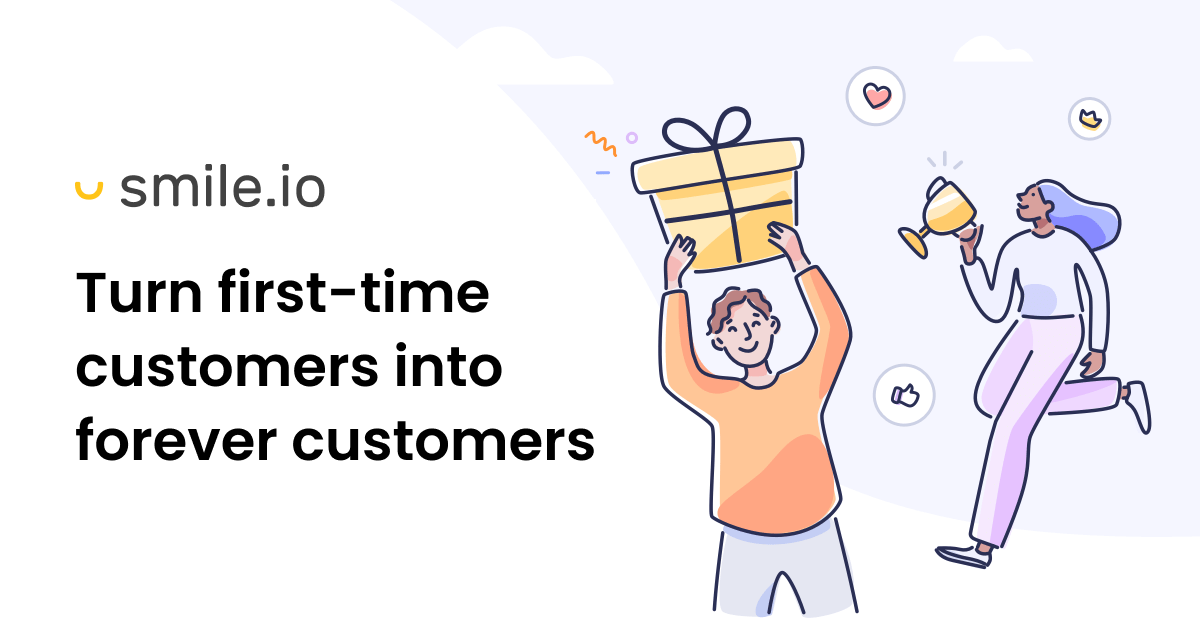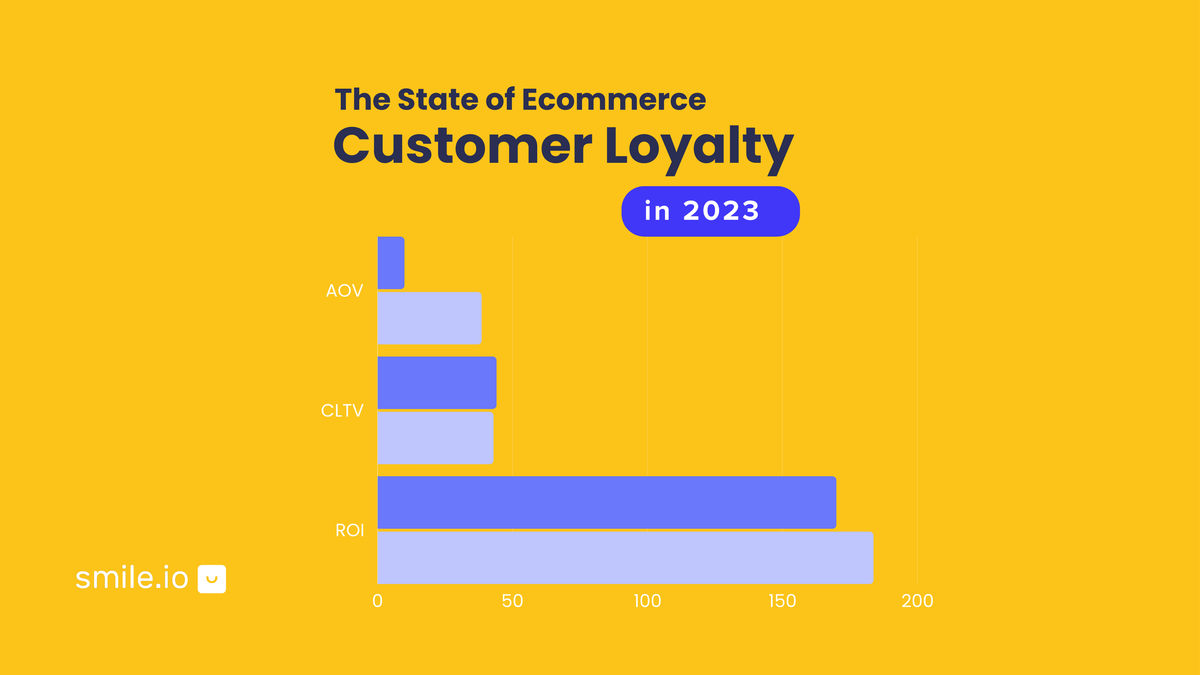- Growing a commerce business involves increasing revenue with increased overhead investments. Scaling a commerce business is increasing revenue without a significant increase in operating costs.
- There are many scaling strategies for commerce brands—laying the foundation for growth, enhancing operational efficiency, expanding market reach, focusing on customer loyalty, and adding programs like Smile.io to retain customers.
- Adding points, VIP, or referral programs with Smile.io can scale your brand by reducing customer acquisition costs, enhancing customer loyalty, and increasing repeat purchases.
- High-volume commerce brands can use Smile Plus to unlock the best of what Smile.io has to offer.
With commerce platforms making it easier than ever to launch and scale a business, ecommerce continues to grow year-over-year. In 2024, global retail ecommerce sales are expected to reach $6.3 trillion U.S. dollars and account for 20.1% of all retail purchases.
Some brands have achieved monumental success within the DTC world, while others have fizzled out. So, what sets the winning commerce brands apart?
The secret to success is knowing how to scale an ecommerce brand efficiently and effectively. Scaling allows you to reach more customers, drive conversions, and increase brand visibility without cutting into your bottom line too much.
It’s important to note that there’s a difference between scaling an ecommerce brand and growing one.
Business growth refers to increasing revenue based on proportionate investments in resources like staff, product research, marketing, operations, or other key areas. While you are technically generating more revenue, overall profits may remain stagnant or decrease due to increased costs.
Strategic scaling of an ecommerce business is when a brand increases revenue without a significant or proportionate increase in operating costs. Scaling a business is a planned strategy focusing on achieving operational efficiencies, international expansion, higher customer loyalty, and more without increased overhead.
As a store owner, learning how to scale your ecommerce business is critical to driving profitability.
Table of Contents:
- Laying the foundation for growth
- Enhancing operational efficiency
- Expanding market reach
- Focusing on customer loyalty and retention
- Introducing Smile.io as a growth catalyst
- Everything you need to know how to scale an ecommerce business
Laying the foundation for growth
You must establish a solid foundation before you can dream of scaling your business to a five, six, or seven+ figure brand.
While you can (and should) iterate over time, you should evaluate your current store’s position based on several fundamental characteristics.
Choose the right ecommerce platform
There are countless ecommerce platforms an entrepreneur can choose from. The factors you consider when starting an ecommerce business differ significantly from those that matter when scaling an ecommerce business.
In the early stages of a business’s lifespan, a bootstrapped entrepreneur will value low costs, ease of use, ready-to-use themes, advanced customer support, and help documentation. The decision criteria evolve once you are ready to scale your ecommerce business.
Consider these scalability factors when choosing an ecommerce platform:
- Omnichannel compatibility—As ecommerce stores scale, new sales channels emerge. Whether expanding into physical retail locations, social commerce, online marketplaces, or international online stores, you need an ecommerce platform that supports you. Shopify Plus and POS are great options for omnichannel commerce.
- Third-party integrations—Many ecommerce platforms are positioned as all-in-one commerce solutions, with products to accomplish many business functions from inventory management, marketing, sales, and more. However, as you scale and aim to create a best-in-class ecommerce store, you should have the flexibility to use best-in-class tools. Ensure your ecommerce platform integrates seamlessly with the tools you’re already using.
- Data and analytics—Despite the wealth of digital data available, 84% of marketing leaders struggle to make data-driven decisions. To avoid falling into this trap, choose an ecommerce platform that makes accessing and analyzing analytics simple. Robust ecommerce analytics programs allow you to measure performance, uncover trends, use customer data, and optimize pricing. Monitor metrics like customer lifetime value (CLV), returning visitor rates, website session time, pages per visit, bounce rate, conversion rates, customer acquisition costs, and more.

Build a solid brand identity
Creating a solid brand identity involves more than visual elements. Visual cues such as brand fonts, colors, logos, and web design help form your brand identity, but they’re not the first step.
When creating your brand, consider first solidifying your:
- Purpose—Why does your brand exist?
- Positioning—How do you want customers to perceive your business compared to competitors? What is your unique selling proposition?
- Promise—What values and customer experience can customers expect every time they engage with you?
- Personality—If your brand were a person, how would it express itself? What tone of voice, core values, and beliefs do you convey with your messaging? Are you funny? Inspiring? Motivating?
Establishing these invisible brand elements will guide your visible elements, which you can apply to all your marketing and sales channels to deliver a cohesive experience as you scale your ecommerce business.
Optimize your website
As an ecommerce brand, your website is your business’s lifeline. Without a physical storefront, an ecommerce website is the first impression a potential shopper will have of your brand. It’s essential to continuously optimize your website to handle a larger influx of customers as you scale efficiently.
Consider factors such as:
- Site speed and reliability—A slow website loading time creates a negative brand perception and harms conversions. According to Google, a one-second site speed improvement can increase mobile conversions by 27%. And 79% of customers are less likely to repurchase from an online store if they are dissatisfied with the site’s speed. Ensure you’re improving your ecommerce site speed by optimizing images, web elements, fonts, and more.
- SEO and marketing tools—Organic discovery is a powerful and cost-effective customer acquisition method. Ecommerce SEO best practices involve keyword research, on-page optimization with valuable product descriptions, website layout, navigation, value-added content like blogs, tutorials, videos, link-building, and more.
- User experience (UX)—Ecommerce user experience (UX) design is the process of thinking from a shopper’s point of view to create a simple, logical, and enjoyable shopping experience. Top UX tips for scaling ecommerce brands include a simplified primary navigation bar, efficient checkout and payment, social proof, website re-engagement campaigns, excellent customer service, and more.
- Mobile optimization—76% of shoppers in the U.S. report buying things online using a smartphone. Choosing an ecommerce platform that is designed for mobile use makes this straightforward.
Enhancing operational efficiency
One of the key aspects of strategically scaling an ecommerce business is being as efficient as possible. With the right ecommerce platform, achieving operational efficiency becomes easier.
Inventory management
Inventory management for ecommerce brands is a supply chain management process that involves tracking stock levels and fulfilling customer orders. As stores scale, they must employ techniques to streamline inventory management without overstocking or understocking products.
Effective inventory management prevents delayed or missed shipments, out-of-stock messages, spoilage, excess inventory, and more to minimize costs and improve profitability.
A Zebra study reveals that reducing over and understocking can lower inventory costs by 10%. Given the financial upside, it’s surprising that 43% of small businesses do not track inventory, and on average, retailers in the U.S. have a supply chain accuracy of just 63%.
Improve your ecommerce inventory management as you scale by:
- Avoiding overstocking—Perform inventory demand forecasting using historical sales data, market trends, and customer behavior. You can implement a Just-in-Time (JIT) inventory approach, where goods are received from suppliers only as they are needed based on customer orders.
- Clearing out excess inventory—Strategically use promotions, bonus rewards campaigns, or time-based marketing events to incentivize customers to buy excess inventory. You can also offer excess inventory products as free product rewards with a loyalty program.
- Investing in inventory management software—There are inventory management tools you can integrate with your ecommerce platform to centralize inventory control, automate the process, integrate with your POS solutions, streamline inventory audits, and improve efficiency.
Automation tools
Automation software saves time and reduces human errors in order fulfillment, payment management, marketing, and more. Consider implementing automation tools for functions like:
- Payment processing—This system allows ecommerce businesses to accept and process online payments from customers in exchange for their products or services. Simplify this process using popular payment processors like Shopify Payments, Stripe, PayPal, Klarna, Amazon Pay, and more.
- Subscriptions—Adding a subscription option to your commerce site can help boost purchase frequency if you sell consumable products. Automate this by implementing tools like Recharge, Loop, or Skio that centralize your subscription management.
- Email and SMS communications—Reaching out to your customers via email or SMS is a key communication channel that maintains an engaged customer relationship. Use marketing automation software to create segments, flows, and event triggers that automatically send communications when a customer performs a specific activity, like making a purchase, abandoning a cart, or earning or redeeming rewards points. Automate email and SMS communications using Klaviyo, Drip, Mailchimp, Omnisend, or GetResponse.
- Lauren Guttormsen, Director of CRM and Loyalty Marketing at Itzy Ritzy

Customer support
An ecommerce brand needs to deliver exceptional and timely customer service. Insights from Zendesk say that 60% of customers choose to purchase from a brand over competitors because of better customer service, and 72% want immediate service.
Growing ecommerce brands should implement scalable solutions for customer inquiries and feedback. Some strategies to consider are:
- Customer FAQ pages—If you notice customers asking the same questions repeatedly, consider adding a Frequently Asked Questions page or section to your website. This way, shoppers can solve their problems before reaching out, freeing up your support team’s bandwidth.
- Customer support software—Add customer support software to your website to create a personalized experience within your live chat and AI chatbots. Choose a tool that integrates with your ecommerce platform and customer accounts, so your support staff has all the relevant customer information at their fingertips. Gorgias, Re:amaze, and Zendesk are all great options.
- Treat social media as a customer support channel—67% of customers find it convenient to contact brands on social media for customer support. Ensure your social media team is trained and equipped to handle customer inquiries. Add an auto-responder into your DMs, letting customers know when they can expect to hear back from you to set clear expectations.

Expanding market reach
An essential element of scaling an ecommerce business is entering new markets to capture new customer segments. Ecommerce brands can take several approaches to expand their market reach.
Omnichannel commerce
The first stage of expanding your ecommerce market reach should be introducing new sales and communication channels through omnichannel marketing and commerce.
In other words, the message should be consistent no matter where a customer engages with your brand. Omnichannel commerce is a strategy to reach customers across different platforms. This involves selling your products across multiple channels, online and offline. Commerce tools like Shopify POS, BigCommerce Point of Sale Apps, and Wix POS make this extremely easy.

Collaborations and partnerships
Ecommerce brands can leverage online creators, influencers, and micro-influencers to tap into new markets that align with their ideal customer profile. Partnering with social media creators allows you to achieve mutually beneficial relationships.
Micro-influencers or user-generated content (UGC) creators are valuable resources because they have built trust with their followers. When they recommend your product, customers are primed to expect it and are more likely to convert or at least remember your brand.
Collaborations and partnerships from third parties create valuable earned media that signal a positive reception to your brand. Seek collaborations with creators who have a community of your target customers, and you can experience the benefits of mutual growth.

International expansion
Another way to scale your ecommerce brand is through international expansion. While the flexibility of ecommerce makes it easier to expand into new geographic regions, there are several considerations for taking your business global.
- Customer demand—Is there customer demand for your product in international markets? Will you face established competition that has a significant market share? Conduct thorough market research to select attractive international markets.
- Localization—Adapt your product and communications for international markets. Cultural differences make monitoring language, packaging, and symbolism important.
- Legal and regulatory compliance—International trade regulations, tax implications, product labeling requirements, safety standards, and other regulatory factors must be considered. Research new market requirements before launching internationally.
- Website optimization—You should create a subdomain or international version of your website for new markets. Ensure your website is translated correctly and supports multicurrency payments in your checkout.
- Customer support—As you scale, maintain good customer service by offering support in local languages and time zones.
Focusing on customer loyalty and retention (top tips)
When a commerce business enters the scaling stage, customer focus should shift from primary acquisition to retention. Repeat customers are more profitable than one-time shoppers, and retaining them allows brands to improve their bottom line with higher revenue and stable costs.
Personalization strategies
Ecommerce businesses can hyper-personalize the customer experience by leveraging customer data. Personalization strategies can increase conversion rates, improve customer experience, and boost average order values.
Some degree of ecommerce personalization is required today, with 70% of consumers stating that they spend more with brands that offer fluid, personalized, and seamless customer experiences.
Tailor the shopping experience to individual customers with personalization strategies:
- Personalized product recommendations—Offer customers product recommendations based on their purchase history, the behavior of similar customers, or previously visited pages. “People Also Viewed” or “Recently Viewed” messages present valuable upsell and cross-sell opportunities that can boost your AOV.
- Tailored website content—Alter your ecommerce website to meet individual shoppers’ demands. This includes personalization based on device type (mobile vs. desktop), location (cater to multiple markets), and pop-ups based on shopper behavior (first-time shopper offers).
- Relevant email and SMS content—Segment your customers and create custom flows to send relevant content based on specific events. This includes messages based on purchase frequency (sending a reminder when a customer typically rebuys), cart abandonment emails, “we miss you” re-engagement messages to dormant customers and more.
- Social retargeting ads—Use social media retargeting ads to target customers who have left your website. The optimal retargeting period is 7-14 days to optimize conversion rates because customers are most likely to remember you then.
- Leverage first and zero-party data—With changes to Google, Apple, Firefox, and other browsers’ privacy rules, first and zero-party data collected with the user’s consent is more important. Use techniques like loyalty programs, product recommendation quizzes, members communities, customer surveys, newsletter sign-ups, mobile apps, and more.
Rewards programs
A loyalty and rewards program is the best strategy for increasing scalable, sustainable repeat customers. The sole purpose of a loyalty program is to turn one-time customers into repeat customers and build a loyal following.
Loyalty programs personalize the customer experience by creating incentives for shoppers based on their past purchases. Customers earn points through making purchases, social media engagement, birthdays, and more to redeem for rewards like discounts on future orders, free shipping, free products, or gift cards.

Scaling commerce brands can maximize their loyalty and rewards program by introducing referrals and VIP tiers. Referrals leverage existing loyal customers to attract new customers by offering a mutually beneficial incentive to both parties. VIP programs offer increasingly attractive perks and benefits the more a customer spends and earns with your brand. As your brand grows, these rewards programs work to keep customers engaged and motivated to make repeat purchases.
- Anthony Mink, Co-founder of Live Bearded

Gathering and utilizing customer feedback
Collecting customer feedback provides opportunities to gauge customer demand, find common pain points, leverage social proof, and humanize your brand.
Common customer feedback collection strategies include:
- Loyalty program data—post-purchase reviews, points accounting data, frequently redeemed rewards, and more.
- Surveys—post-purchase surveys, customer satisfaction surveys, Net Promoter Score (NPS) surveys, or general feedback surveys.
- Social media—engagement metrics, online polls, social listening, and brand communities.
- On-website data—website analytics from GA4, ecommerce platform data, online quizzes, and live chats.

Once you’ve collected valuable customer data, you can use it to guide business decisions. This personalizes the customer experience because customers feel valued, heard, and important when you listen to their opinions, forging an emotional relationship with your brand.
Introducing Smile.io as a growth catalyst
Your tech stack must scale with you as you scale your commerce business. Smile.io is the world’s largest loyalty program provider on Shopify, BigCommerce, and Wix. Implementing Smile.io can help scale your business by enhancing customer loyalty and increasing repeat purchases.

With over 100,000 ecommerce loyalty programs powered by Smile.io, our best-in-class software increases repeat purchase rates, and average order value, and decreases purchase frequency. In 2023, loyalty spend ROI averaged +676% across all merchants.
Smile.io lets you quickly launch a points, referral, and VIP rewards program that is endlessly customizable and effortless to manage.

Our newest Smile Plus Plan is for high-volume brands looking for a customer loyalty program that will scale with them.
With Smile Plus, high-volume scaling commerce brands can:
- Embed loyalty where it matters.
- Launch quickly and manage efficiently.
- Access an expert loyalty partner.
- Review loyalty program data on demand.

Everything you need to know how to scale an ecommerce business
There are many moving parts when it comes to how to scale an ecommerce business. With the potential for improved profit margins, higher efficiency, and significant brand exposure, there is a clear upside to scaling your commerce business.
To scale your ecommerce business as effectively as possible, consider the following key steps:
- Lay the foundation for growth. Choose the right ecommerce platform, build a solid brand identity, and optimize your website.
- Enhance operational efficiency. Introduce ecommerce tools to help you with inventory management, automation, and customer support.
- Expand market reach. Consider strategies like omnichannel marketing and commerce, international expansion, and collaborations or partnerships to scale your business and reach new potential customers.
- Focus on customer loyalty and retention. Since repeat customers are more profitable than one-time shoppers, use personalization strategies, loyalty and rewards programs, and customer feedback to guide business decisions.
- Add a Smile.io loyalty program as a growth catalyst. Seamlessly launch a best-in-class points, referral, or VIP program. For scaling high-volume brands, consider Smile Plus. Enterprise loyalty made easy.












